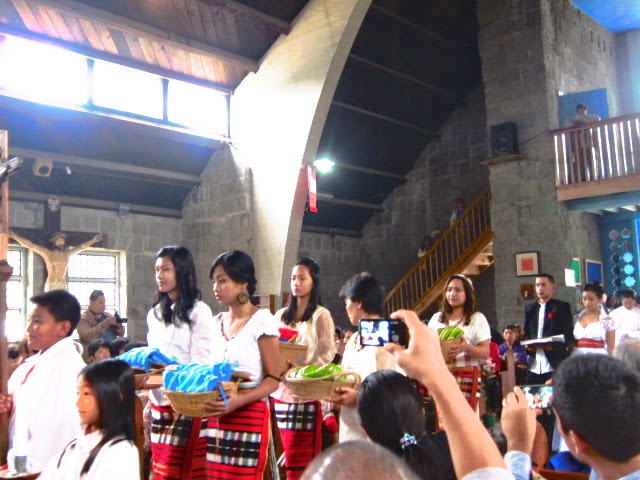 |
| The altar of The Church of St. Mary the Virgin |
The rituals started that afternoon, with the curing of the meats to be served on the last day of the celebration. The celebration would last for three more days but the main event was the church and wedding day reception.
Before anything else, I cannot emphasize enough that when attending a wedding in Sagada especially on a cold November day, it is perfectly okay to wear boots, a scarf or even pants. I, on the other hand, was wearing a cocktail dress and strappy shoes because I had to pack light for this Banaue-Sagada trip.
During the start of the wedding, I was happy to see that the couple included their native roots to the celebration by incorporating the native woven cloth in the women's dresses. The communion was like a procession of elderly Sagada women wearing their finest native frock and beads. The church ceremony lasted for two hours with some parts similar to our Catholic mass. The rest were in the vernacular so I did not understand it but the solemnity of the wedding and the packed church was evident of how strong their religion ties are.
After the wedding, we went back to our hotel to get our jackets before heading to the bride's home for the reception. Their home is isolated from the rest of the town. We walked for about tree kilometers each way to and from the reception area, with tourists in jeeps and vans looking at us weird because everyone else were dressed for hiking and spelunking while we were in a cocktail dress and long sleeved dress shirt.
Along the way I was puzzled to see people carrying food in plastic bags and going the opposite direction. It looked like they had already come from the wedding and were about to go home.
When we got there, the feast had already started and it looked like everyone was invited. There were men playing the gongs while dancing.
The couple was in the registration table which was decorated with a native signage and big containers of fermented rice wine. As a guest approaches the couple, they give a white bowl with their printed names in exchange for the gifts.
After the registration was a challenge of where to sit. One can choose to watch the several performances outside or go straight to the dining and living area, get food and find a place to eat. There was red rice, salad, pancit and several meat dishes including cold cured beef. We sampled some of them. There were also plastic takeout bags for those who want to enjoy their meal at home. This explains the procession of people that we saw earlier carrying food in plastic bags.
It may seem chaotic for someone from the city who is used to organized
celebrations and wedding coordinators but being in this celebration
showed me their deep sense of community where everyone is like family.
This shows the food still being cooked as the celebration goes on. We were told that it will last all day until the next morning so the cooking probably will not stop until then.
There were village elders serenading the couple and performing dance numbers.
By early afternoon the temperature dropped to 10 degrees celsius so we already left! As we were walking away, I could not help but admire the beautiful view in the bride's family home.
The bride is a native of Sagada who studied in Up Diliman and came to live in Baguio for several years. Seeing her marrying a man of Sagada and choosing to wed and settle in her native town just shows that no matter how far we come, we can never deny our roots and we will always crave to go back to the place we call home.
Cheers to the happy couple!
























